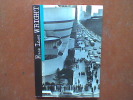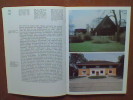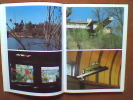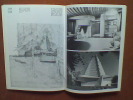TREIBER Daniel
Frank Lloyd Wright
Fernand Hazan, 1986, 133 p., in-8 br., coll. "Architecture", nombreuses illustrations photos n. et b. et couleur, couverture rempliée, bon état
Reference : QWA-4419
Diverse, considérable, étrange, en tout cas différente, l’œuvre de Frank Lloyd Wright (1867-1959) reste encore mal connue. Le livre de Daniel Treiber s’attache à suivre les grandes métaphores de cet art de construire original : avec sa lisibilité, avec ses textures matérielles très savantes, son raffinement, ses oscillations entre le spectaculaire et le caché, le transparent et l’opaque, le lisse et le rugueux. La nouvelle édition de cette monographie, parue en 1985, est entièrement refondue, enrichie de nouveaux chapitres d’une iconographie nouvelle. On y découvre l’inventeur d'un nouveau type de maison, plus pratique et plus agréable à vivre par rapport notamment au climat, Wright étant celui qui a fait le plus pour changer le lieu où nous habitons. Deux chapitres supplémentaires viennent enrichir l’ouvrage. L’auteur analyse comment Wright a été un précurseur de la "ville diffuse" d'aujourd'hui, la ville à la campagne, comment il voyait l’intégration du contemporain dans une ville ancienne, par exemple à travers le projet Masieri pour Venise, qui se serait magnifiquement intégré, sur la Grand Canal. La présentation d’une modernisation exemplaire d'un immeuble, construit par un autre architecte, offre une leçon qui surprendra les thuriféraires épris exclusivement chez Wright de la figure du précurseur de la modernité, avec les "maisons de la Prairie", ou l’auteur de Fallingwater et de maisons individuelles) à quoi se résume trop souvent son historiographie. Un autre nouveau chapitre traite des rapports entre Wright et le Japon, les valeurs culturelles dont Wright a transposé les valeurs culturelles, en particulier, « l’hétérogène » et le « refus de l’unité » que Wright a transposées dans son architecture. Sans oublier le rapport à la nature et au paysage, thème plus que jamais en faveur aujourd’hui
Bookseller's contact details
Librairie de la Garenne
M Christian Boyer
01 42 70 11 98
Payment mode
Sale conditions
Vente par correspondance uniquement. Conformes aux usages de la librairie ancienne et moderne. Les prix indiqués sont nets. Les frais de port sont en sus. Les livres peuvent être commandés ou réservés par téléphone, courrier ou courriel. Paiement par chèque ou virement
5 book(s) with the same title
Urbanism of Frank Lloyd Wright.
, Princeton University Press, 2015 Hardcover, 446 pages, ENG, 285 x 245 x 40 mm, New, dustjacket, fully illustrated in colour / b/w. ISBN 9780691167534.
This is the first book devoted to Frank Lloyd Wright's designs for remaking the modern city. Stunningly comprehensive, The Urbanism of Frank Lloyd Wright presents a radically new interpretation of the architect's work and offers new and important perspectives on the history of modernism. Neil Levine places Wright's projects, produced over more than fifty years, within their historical, cultural, and physical contexts, while relating them to the theory and practice of urbanism as it evolved over the twentieth century. Levine overturns the conventional view of Wright as an architect who deplored the city and whose urban vision was limited to a utopian plan for a network of agrarian communities he called Broadacre City. Rather, Levine reveals Wright's larger, more varied, interesting, and complex urbanism, demonstrated across the span of his lengthy career. Beginning with Wright's plans from the late 1890s through the early 1910s for reforming residential urban neighborhoods, mainly in Chicago, and continuing through projects from the 1920s through the 1950s for commercial, mixed-use, civic, and cultural centers for Chicago, Madison, Washington, Pittsburgh, and Baghdad, Levine demonstrates Wright's place among the leading contributors to the creation of the modern city. Wright's often spectacular designs are shown to be those of an innovative precursor and creative participant in the world of ideas that shaped the modern metropolis. Lavishly illustrated with drawings, plans, maps, and photographs, this book features the first extensive new photography of materials from the Frank Lloyd Wright Foundation Archives. The Urbanism of Frank Lloyd Wright will serve as one of the most important books on the architect for years to come.
Reference : albd3dca16569fc8800
Bergdoll Barry Gray Jennifer. Frank Lloyd Wright: Unpacking the Archive Frank Lloyd Wright: Unpacking the Archive. In
"""Bergdoll Barry Gray Jennifer. Frank Lloyd Wright: Unpacking the Archive Frank Lloyd Wright: Unpacking the Archive. In Russian (ask us if in doubt)./Bergdoll Barry & Gray Jennifer. Frank Lloyd Wright: Unpacking the Archive Frenk Lloyd Rayt: Raspakovyvayu arkhiv. With essays by Michael Desmond Carole Ann Fabian Elizabeth S. Hawley Juliet Kinchin Neil Levine Ellen Moody Therese O'Malley Ken Tadashi Oshima Michael Osman Spyros Papapetros Janet Parks Matthew Skjonsberg David Smiley and Mabel O. Wilson. T New York MoMA 2017 256 c. SKUalbd3dca16569fc8800."""
Frank Lloyd Wright : L'uomo al di sopra della macchina. L'oeuvre de Franck Lloyd Wright pendant ses dix dernières années. Una mostra della sua opera nell'ultimo decennio presentata dagli stati uniti d'america alla XII Triennale di Milano.
Milano,1960, In-8 carré, agrafé, 36 pp.
Catalogue de l' exposition sur Frank Lloyd Wright à la XII Triennale de Milan, bien complet de la feuille volante avec la traduction du texte en français, anglais et allemand.
Frank Lloyd Wright : His Living Voice
, Press at California State University, Fresno / CSUF, 1987 Hardcover, 207 pages, ENG, 235 x 160 mm, in good condition, dustjacket, ill. in b/w. ISBN 9780912201139.
Frank Lloyd Wright (June 8, 1867 ? April 9, 1959) was an American architect, designer, writer, and educator. He designed more than 1,000 structures over a creative period of 70 years. Wright played a key role in the architectural movements of the twentieth century, influencing architects worldwide through his works and hundreds of apprentices in his Taliesin Fellowship. Wright believed in designing in harmony with humanity and the environment, a philosophy he called organic architecture. This philosophy was exemplified in Fallingwater (1935), which has been called "the best all-time work of American architecture".
Exposition de l'oeuvre de Frank Lloyd Wright.
Paris. Ecole Nationale Supérieure des Beaux-Arts, 1952. Plaquette in-8 carrée agrafée de 16 p. Textes de F. L. Wright, note biographique, liste des documents exposés, etc. Bien complet du supplément de 4 pages avec le texte : L'architecture organique regarde l'architecture moderne par F.L. Wright. E.O.
 Write to the booksellers
Write to the booksellers






